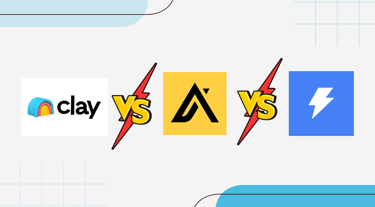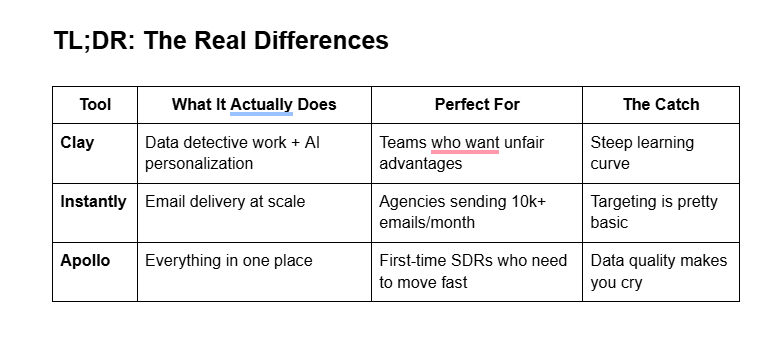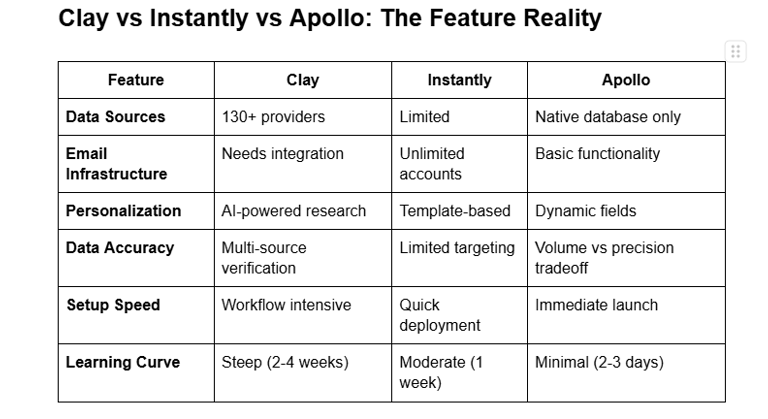Clay vs Instantly vs Apollo: Which Cold Outreach Tool Actually Works in 2025?
GROWTHSAAS
7/31/20256 min read


Clay vs Instantly vs Apollo isn't just another tool comparison. It's the difference between building a revenue machine that scales vs throwing money at software that doesn't move the needle.
Let’s be straight with you - most teams pick the wrong tool. Then they wonder why their cold outreach feels like screaming into the void.


Here's what nobody tells you: these tools solve completely different problems. Picking the wrong one is like bringing a knife to a gunfight.
Why Your Tool Choice Defines Your Entire Strategy
Most founders think they're comparing features. Wrong.
Clay users bet on precision, backed by a significant budget. They believe deeply researched, hyper-relevant outreach wins—and are willing to pay for it, with top plans reaching $800/month.
Instantly users bet on volume. They think consistent, high-volume email with basic personalization still converts.
Apollo users bet on consolidation. They want everything working today, even if it's not perfect.
Each approach can work. But only if you know which game you're actually playing.
Clay: The Data Nerd's Dream (And Nightmare)
What Clay Actually Is
Clay isn't a sales tool. It's a Lead Enrichment tool
Think of it as the middleman between 130+ data sources and your outreach campaigns. Instead of guessing, you build workflows that pull intel from everywhere.†
Where Clay Crushes Everyone
Multi-Source Data Enrichment: While other tools give you one data point, Clay checks multiple sources until it finds the truth. Your data accuracy jumps from 60% to 85%+.
AI Research That Actually Works: Claygent can analyze someone's recent LinkedIn posts, summarize their podcast appearances, or spot technology changes at their company. At scale.
Custom Workflow Building: Want to target engineering leaders who tweeted about performance issues this week? Clay builds that workflow. Automatically.
Real Clay Results
Teams using Clay's Twitter sentiment targeting see 35%+ reply rates. Compare that to generic outreach getting 2-5%.
The secret? They're hitting prospects when pain points are fresh and top-of-mind.
Clay's Hidden Costs
Premium Price Point: With plans climbing to $800/month, Clay is a significant investment before you even account for usage.
Learning Curve From Hell: Plan on 2-4 weeks to get proficient. Reviews consistently mention needing a "spreadsheet expert" mindset.
Credit Burn Risk: Inefficient workflows burn through thousands of dollars fast. The usage-based model doesn't forgive mistakes.
No Built-In Sending: You'll need Gmail, Instantly, or another platform for actual email delivery.
When Clay Makes Sense
You're building a defensible revenue engine. You have technical resources. You believe superior targeting beats volume every time.
Instantly: The Email Infrastructure Play
What Instantly Really Solves
Instantly was built by agency owners tired of per-seat email costs eating their margins.
Core innovation: unlimited email account management with automated warm-up and rotation.
Where Instantly Dominates
Email Account Scaling: Spin up 50+ accounts without manual DNS configuration. Game-changer for agencies.
Volume Economics: Flat-rate pricing eliminates per-seat costs that kill agency profitability.
Clean Interface: Most intuitive platform in the space. Important when training multiple team members.
Real Instantly Results
Agencies running 50+ warmed accounts through Instantly generate 1,000+ qualified leads monthly while maintaining sender reputation.
The magic is in the infrastructure, not the targeting.
The Instantly Reality Check
Here's what nobody talks about: A common theme in user forums and technical communities is the reported discrepancy between Instantly's native deliverability scores and results from independent, third-party validation tools. Reports of blacklisted domains passing in-app checks are frequent enough to warrant skepticism.
Other Concerns:
Shallow targeting compared to Clay or Apollo
Mixed reviews on technical support
Your reputation partially depends on other users' behavior
When Instantly Makes Sense
You're an agency or high-volume team with proven messaging. Your bottleneck is sending capacity, not targeting intelligence.
Apollo: The All-in-One Gamble
What Apollo Actually Delivers
Apollo combines a 275M+ contact database with email sequencing, cold calling, and basic CRM functions.
Designed to be the fastest path from zero to live campaigns.
Where Apollo Excels
Speed to First Campaign: Build lists and launch sequences within hours of signing up. Unmatched.
Consolidation Play: Search, enrich, sequence, call - all from one dashboard. No integration headaches.
Generous Free Tier: 10,000 email credits monthly makes it accessible for bootstrapped teams.
Real Apollo Results
Solo founders use Apollo to launch outbound campaigns in hours instead of weeks. Typical response rates: 12-15% with minimal setup time.
The value is speed and simplicity, not perfection.
Apollo's Accuracy Problem
Here's the elephant in the room: users consistently report 20-30% bounce rates on "verified" Apollo emails.
Reddit user feedback: "Apollo's data accuracy is terrible. Getting 25% bounces on verified contacts."
The Tradeoff: Apollo's scale-first model means breadth over precision. To offer 275M+ contacts at their price point, they accept higher error rates.
When Apollo Makes Sense
Your team prioritizes having a single, end-to-end platform for prospecting and outreach. Whether you're an early-stage team avoiding complexity or a larger organization aiming to consolidate your stack, Apollo makes sense when an all-in-one system is more valuable than integrating multiple specialized tools.
The Advanced Play: How Smart Teams Stack These Tools
The most sophisticated teams don't choose one tool. They architect systems.
The "Unfair Advantage" Stack:
Apollo for Initial Prospecting: Use the massive database for list building and basic filtering
Clay for Deep Enrichment: Import Apollo lists for waterfall enrichment and AI personalization
Instantly for Volume Execution: Send Clay's enriched campaigns through Instantly's infrastructure
This approach costs more upfront but creates sustainable competitive advantages.


The Metrics That Actually Matter in 2025
Stop celebrating open rates. Start measuring what drives revenue:
Leading Indicators:
Bounce rate below 5% (shows quality targeting)
Positive reply rate above 15% (indicates message relevance)
Multi-touch engagement across channels
Revenue Indicators:
Pipeline velocity from first touch to opportunity
True customer acquisition cost (including tool costs and time)
Revenue per campaign hour invested
Strategic Recommendations by Business Stage
Early-Stage Founders (Pre-PMF)
Choose Apollo if your primary goal is speed to launch or you're committed to an all-in-one platform. Your enemy is complexity and inaction, and Apollo provides 80% of what you need with 20% of the complexity. Focus on finding product-market fit, not perfecting your tech stack.
High-Volume Agencies (5-50 Clients)
Choose Instantly as foundation. Your business model depends on scalable execution. Add Clay selectively for premium clients who justify deeper research investments.
Mature Growth Teams ($10M+ Revenue)
Choose Clay as your intelligence layer. You're building a defensible revenue engine, not just doing outreach. Clay's data orchestration creates sustainable competitive advantages that compound over time.
The Future of Cold Outreach Tools
Generic, high-volume outreach is dying fast. Buyers are more sophisticated, and sender reputation is more fragile than ever.
According to Gartner's research, B2B buyers spend only 17% of their purchase journey meeting with potential suppliers. The rest happens in research mode - which means your outreach better be relevant when it lands.
The trend is clear: Personalized, deeply researched outreach sees 3-5x higher response rates than generic campaigns.
Your tool choice determines whether you're ahead of this trend or behind it.
Bottom Line: Choose Your Competitive Advantage
The question isn't which tool is "best." The question is: what type of competitive advantage will you build?
If you're a B2B startup ready to move beyond basic outreach and build a sophisticated revenue engine with these tools, BriskFab helps growth teams architect the right stack for their stage and strategy. We've seen too many companies waste months (and budget) on the wrong tool choice.
For more insights on building effective demand generation strategies that complement your outreach efforts, check out our comprehensive playbook.
Clay vs Instantly vs Apollo represents three different bets on the future of B2B sales. Choose the one that aligns with your strategy, resources, and beliefs about what drives revenue.
Your outreach engine should be a competitive moat, not just another cost center.
Frequently Asked Questions
Is Apollo's data accuracy really that bad?
Yes. Multiple user reports show 20-30% bounce rates on "verified" emails. While this doesn't kill Apollo's value for early-stage teams, it's a real limitation for reputation-focused campaigns.
Can I trust Instantly's deliverability scores?
Be skeptical. Reddit users frequently report discrepancies between in-app scores and third-party testing tools. Always validate with external deliverability checkers.
Is Clay worth the complexity?
Only if you have technical resources and believe superior targeting beats volume. Clay requires significant learning investment but delivers disproportionate results for teams who master it.
What's the most common tool evolution path?
Apollo (speed) → Clay (intelligence) → Instantly (scale). Each layer adds capability while maintaining previous foundations.
How much should I budget beyond subscriptions?
Factor in learning time, additional data costs (Clay credits average $200-500/month), and integration tools like Zapier ($20-100/month).
